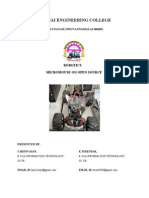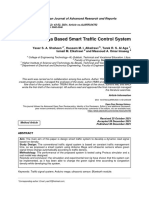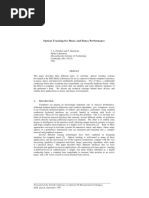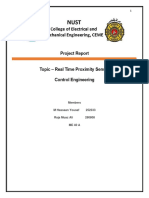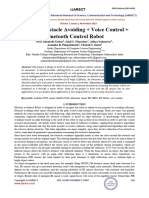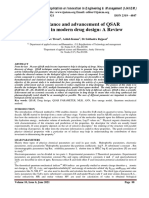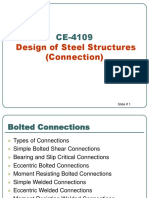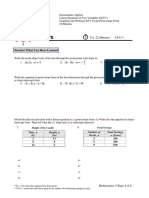Intelligent Cane Robot For Walking Assistance of Elder and Handicapped People
Intelligent Cane Robot For Walking Assistance of Elder and Handicapped People
Copyright:
Available Formats
Intelligent Cane Robot For Walking Assistance of Elder and Handicapped People
Intelligent Cane Robot For Walking Assistance of Elder and Handicapped People
Original Title
Copyright
Available Formats
Share this document
Did you find this document useful?
Is this content inappropriate?
Copyright:
Available Formats
Intelligent Cane Robot For Walking Assistance of Elder and Handicapped People
Intelligent Cane Robot For Walking Assistance of Elder and Handicapped People
Copyright:
Available Formats
International Journal of Emerging Trends & Technology in Computer Science (IJETTCS)
Web Site: www.ijettcs.org Email: editor@ijettcs.org, editorijettcs@gmail.com Volume 2, Issue 5, September October 2013 ISSN 2278-6856
INTELLIGENT CANE ROBOT FOR WALKING ASSISTANCE OF ELDER AND HANDICAPPED PEOPLE
G.PRABHAKAR REDDY, K . SATISH BABU
DEPARTMENT OF ELECTRONICS AND COMMUNICATION ENGINEERING AURORAS TECHNOLOGICAL AND RESEARCH INSTITUTE Parvathapur, Uppal, Hyderabad-500 039
Abstract: The main aim of the project is to design An
intelligent cane robot for aiding elderly and handicapped peoples walking. Our system is designed by using ARM 32bit micro controller which supports features for the development of cane robot. Our robot is used as a support for elders and for handicapped people. Our system contains ultrasonic sensors and IR sensor and motors for controlling movement. We use three ultrasonic sensors placed at three directions of robot which detects leg movement of person then based on that leg movement robot direction gets changes. If a person tries to move straight the ultrasonic sensor detects his leg movement then simultaneously cane robot also moves one foot forward. If ultrasonic sensor connected at sides detects leg movement then it changes one foot either left or right direction. The IR sensor is connected to robot at front which is used to detect obstacles in front. When it detects obstacles in front of it then it automatically stops movement of robot. Motors connected to controller are used for robot movement. For holding stick by person we use cane through this movement is controlled.
optimized actions, one of the most important tasks that should be accomplished by the robot is to correctly estimate the users walking intention by his leg moment. From the viewpoint of the robot control system, the users walking intention of the leg provides the robot motion controller. Therefore, in this paper focus on the design of robot motion control strategy, in which the users walking intention should be explicitly find by his leg moment this control strategy plays an important role in the design System Architecture
Keywords: Sensors, cane robot, ARM, dc motors, line drivers
Introduction
More number of people aged in next generation due to yearly increasing aged people ratio compared to other people An on average only 10 % are aged now, and it is estimated to reach 21% in 2050. Loosing complete or part of mobility, affects not only the ability to walk but also the affect on daily life, that is a major determinant in life quality and causes dependence of others in daily life. In an aging society it is extremely important to develop devices, which can support and assist the elderly people by moving robot in his intentional direction . Elderly tend to have cognitive impairments and experience more serious falls but there is strong evidence that daily exercise may result on fall prevention and postural stability. So, it becomes becomes more and more relevant to find ways and tools to compensate to improve or to restore and to enhance this mobility[4]. Intelligent cane robot is to perform optimized actions to help the users walking or facilitate their recovery. The sanctions include guiding, fall pre-venting, rehabilitation training, and so on. To provide these Volume 2, Issue 5 September October 2013
The S3C2400 was developed using an ARM920T core, 0.18um CMOS standard cells and a memory complier. Its Low-power, simple, elegant and fully static design is particularly suitable for cost-sensitive and power sensitive applications. Also S3C2400 adopts a new bus architecture, AMBA (Advanced Microcontroller Bus Architecture) An outstanding feature of the S3C2400 is its CPU core, a 16/32-bit ARM920T RISC processor designed by Advanced RISC Machines, Ltd. The ARM920T implements MMU, AMBA BUS, and Harvard cache architecture with separate 16KB instruction and 16KB data caches, each with a 8-word line length. Ultrasonic distance sensors consist of 3 major parts: A transmitter, a receiver and a timer. To measure a distance the timer triggers the transmitter which emits a series of pulses, then the timer waits until the receiver detects the reflection of the pulses and stops the timer. The time Page 134
International Journal of Emerging Trends & Technology in Computer Science (IJETTCS)
Web Site: www.ijettcs.org Email: editor@ijettcs.org, editorijettcs@gmail.com Volume 2, Issue 5, September October 2013 ISSN 2278-6856
measured is then divided by 2 and multiplied with the speed of sound. The result is the distance between the sensor and the object in front of it. The transmitter sends out a stream of pulses on a carrier frequency. The maximum frequency humans can hear is about 20 KHz. A frequency higher than that is picked to avoid annoying humans with the constant beep -- 40 KHz is a common value. The receiver triggers when it receives a signal with that particular frequency. This is not necessary the signal the transmitter sent. If more than one ultrasonic sensor with the same carrier frequency are used, they can detect each others signals. Sound doesn't move in a straight line, but rather as a 3D expanding wave. When the wave reaches an object part of it bounces back and moves again as a 3D expanding wave in the opposite direction. Such a wave can easily bounce multiple times before disappearing. So it is very possible that you receive pulses that have travel a much larger trajectory than just to and back from the object in front of the sensor. While some part of this problem can be solved by letting the sensor wait some time before starting another measurement, other situation can produce incorrect measurements which are fairly tough to correct. For example moving through a doorway can fail because the sensors emitted pulses bounce from the walls back to the sensor and so giving a measurement that indicates an object in front of the sensor. One way of correcting this is using another sensor, for example a IR distance sensor to see if there really is an object. However such solution pose another problem: which sensor to believe? 3 sensors allow you to go with the majority, but then things become quite complicated in constructing and interfacing such systems, not to mention what it does to the power consumption. Distance Formula The formula for calculating distance from a sonar pulse looks like: vision. Because sound propagates as a 3D pressure wave, the sensor actually has a range that resembles a sinc function wrapped around a curve. Potential Problems Sonar sensors work very well for collision avoidance in large areas, but they do have some limitations. Because sound propagates out as a 3D pressure wave and echoes, your robot may see things that are not really in its way. For instance, near angled walls the sound waves may bounce several times before returning to the sonar receiver. This makes it difficult for the robot to know which echo is actually the correct distance to the nearest obstacle Similar to this is the problem of having multiple sonar sensors operating the in the same area. If the frequencies of nearby sonar sensors are too similar they may cause false readings since the sensors have no method besides frequency to distinguish pulses it sent out from those other sensors send out. Another common problem is the difference in absorbency and reflection of different materials. If you shoot a sonar pulse at a cloth covered wall (i.e. cubicle), it is likely that the cloth will absorb a significant amount of the acoustic energy and that the robot will not see the wall at all. On the opposite end of the spectrum, a floor with very high acoustic reflection may register as an obstacle when it is really a clear plane The L293D motor driver is available for providing User with easy and user friendly interfacing for embedded application. L293D motor driver is mounted on a good quality, single sided non-PTH PCB. The pins of L293D motor driver IC are connected to connectors for easy access to the driver ICs pin functions. The L293D is a Dual Full Bridge driver that can drive up to1Amp per bridge with supply voltage up to 24V. It can drive two DC motors, relays, solenoids,etc. The device is TTL compatible. Two H bridges of L293D can be connected in parallel to increase its current capacity to 2 Amp. Software 343 m/s is the speed of sound, and we need to divide the time by 2 because the sound travels out and back. Availability & Range Sonar sensors are widely available and relatively inexpensive, ranging from $15 to $40 depending on the desired range. On average the maximum range of a midlevel sonar sensor will be between 4 and 6 meters. Unlike infrared or laser sensors, sonar sensors also have a minimum sensing distance as well. This is due to the fact that the distance measurements are based on the speed of sound, and over very short ranges the sound travels out and back more quickly than the circuitry can respond. This minimum distance will vary by sensors, but is typically around 2 to 5 centimeters. Also unlike infrared sensors, sonar sensors dont have a perfect cone of Volume 2, Issue 5 September October 2013 Softwares are used in ARM micro controllers 3 things are required Boot Loader,Kernel, Root File System the main functionality of boot loader is to initialize all the devices that are present on the arm board kernel is a computer program that manages input/output requests from software into data processing instructions for the central processing unit and other electronic components of a computer. The kernel is a fundamental part of a modern computer's operating system. Root File System will tell how files arrangement there inside the internal standard storage devices Qt[5] is a cross-platform application framework that is widely used for developing application software with a graphical user interface (GUI) and also used for developing non-GUI programs such as command-line tools and consoles for servers. it uses standard C++ and can be used in several Page 135
International Journal of Emerging Trends & Technology in Computer Science (IJETTCS)
Web Site: www.ijettcs.org Email: editor@ijettcs.org, editorijettcs@gmail.com Volume 2, Issue 5, September October 2013 ISSN 2278-6856
other programming languages via language bindings. It runs on the major desktop platforms and some of the mobile platforms. As Qt is based on C++, it can be easily ported on to different platforms, such as Embedded Linux, Windows WALKING MODES OF CANE ROBOT between any two walking modes. Therefore, all possible modes among the four modes are illustrated in Fig3.Walking intention in different walking modes is found by using sensors that are Ultrasonic sensor Sensors in 001 mode S3 S1 Vin S2 Initialize sensors input Yes S4 Read line No Figure 2 block diagram of h bridge Table1 modes of operation S2 S3 S4 Result 0 1 0 1 0 0 1 0 0 1 1 0 0 1 0 Motor moves right Motor moves left Motor free runs Motor brakes Motor brakes Figure 3 flow chart of modes operation Interfaced to robot. The current position and posture of cane robot are inferred from the sensory data mounted on the robotic wheels. To ensure the safety of cane robot. The output of motion controller is also restricted by some thresholds, which can avoid the sudden change of robot movement. The state of user is monitored by multiple sensors interfaced to robot. The current position and posture of cane robot are inferred from the sensory data mounted on the robotic wheels. All modes of operations of cane robot function is designed by using h bridge in which depending on the switch positions rotate the robotic wheels CONTROL SYSTEM OF CANE ROBOT The intelligent cane robot motion controller uses an sensors to control motion of robot based on the inferred human intention, which is called the Intentional direction cane robot. By utilizing some sensor fusion approaches, the state of user can then be reliably recognized and provided to the motion controller. The cane uses sensors detect mode of operation then the user a feeling as if he is interacting with the system specified by the modl. This model is dened as a transfer function with the user as the input and the reference cane robot as the output. It is during walking, people feel comfortable if the cane is easily moved in intentional direction then user can feel better .In this system intentional direction is important to Page 136 Sensors in 111 mode Sensors in 000 mode Sensors in 100 mode Sensors in110mode Sensors in 011 mode Mot or cont rol Sensors in 010 mode
S1 1 0 0 0 1
In order to facilitate the development of walking model and control strategy, the cane robot systems is illustrated first . As shown in Table1. To describe the human walking intention during using the cane robot, an important concept is introduced as follows. The direction to which a person intends to move is referred to as the intentional direction (ITD) . The ITD can be evaluated by the leg moment between the forward direction and the ITD[2] itself. Obviously, the ITD is a time-dependent value on sensor , the quantity of this intention is characterized by the corresponding sensor activation along the ITD. To formulate the walking intention quantitatively, it is required to obtain ITD. The first thing we should do is to enumerate possible human walking modes. Although there are plentiful of possible modes during walking, only several of them are often used in the daily life. In this study four simple walking modes are considered, which are listed in Table I. We assume that there are four main types of walking modes including Stop (mode I), Go forward (mode II), and Turn left (mode III), and Turn right(mode IV) in daily life. Furthermore, mode II mostly used. A typical case of human walking mode turns around. Mode is obtained by using mode III or mode IV. During walking, empirically, we know that change of mode may occur Volume 2, Issue 5 September October 2013
International Journal of Emerging Trends & Technology in Computer Science (IJETTCS)
Web Site: www.ijettcs.org Email: editor@ijettcs.org, editorijettcs@gmail.com Volume 2, Issue 5, September October 2013 ISSN 2278-6856
which direction movement will be is the first then the corresponding sensor has to activate and then which
Figure 5: ARM9 Main circuit Board It is for the Samsung S3C2440 processor and the use of professional power stable core CPU chip to chip and reset security permit system stability. The mini2440 Immersion Gold PCB using the 4-layer board design process, professional, such as long-wiring to ensure that the key signal lines of signal integrity, the production of SMT machine, mass production; the factory have been a strict quality control, with very detailed in this manual can help you quickly master the development of embedded Linux and WinCE process, as long as there is C language based on the general entry to two weeks. To choose the development board startup mode, S2 DIPswitch is determined, Depending on the target board tips. Switch S2 to _NOR" side logo, the system will start with the NOR flash. Switch S2 to _NAND" side logo, system will start with the NAND Flash. On-board 64 MB NAND flash, Power-down non-volatile On-board 2 MB NOR flash, Power-down non-volatile, BIOS has been installed The NOR Flash and NAND Flash of the development board has been burned into the Same BIOS from factory (because the BIOS at the same time support for both flash The Motor Board in the following Figure 7 provides motor control up to three DC motors. The supply power needs two +12V DC supply that connects serially to the motor drivers. One LED to indicate whether the board is being supplied or not is located at the top right of the board while the all the three motors have their own drivers to control all three dc motors
Figure 4 flow chart of robot control operation Direction to move to rotate the robot position. To meet the requirement, we propose scheme in which two models are used. One model is dened for the motion along the intentional direction. The other model is dened for detecting any obstacle in front of the robot The general idea is shown in Fig. 4.The model for our cane robot is dened as based on the current walking mode, The control diagram of the whole cane robot system is shown inFig.4 At each control period the interactive sensors between the user and the cane robot is measured by the sensors. The current robot positions are measured by the sensors. Once the position of robot is find then to move left or right rotate robot slightly in intentional direction then drive the robot forward direction all two models designed for robotics is shown in fig.4 finally the robot allocated to the three wheels. HARDWARE Figure 6 below shows the Main Board that contains USB connected I/O pins and+5V DC supply. The red indicator LED wills lights up whenever the supply is served to the board. The LPC2148 is powered by +5V DC supply that is being regulated from theLM7805 voltage regulator. The Main Board also has a pushbutton to reset the program whenever it is needed. Mini24440 is a practical low-cost ARM9 development board, is currently the highest in a cost-effective learning board. It is for the Samsung S3C2440
Figure 6: Motor Board circuit with pin assignment Page 137
Volume 2, Issue 5 September October 2013
International Journal of Emerging Trends & Technology in Computer Science (IJETTCS)
Web Site: www.ijettcs.org Email: editor@ijettcs.org, editorijettcs@gmail.com Volume 2, Issue 5, September October 2013 ISSN 2278-6856
RESULT AND ANALYSIS [3] Rehabilitation. IEEE International Conference on Robotics and Biomimetics. ROBIO '06. K. Yamamoto, M. Ishii, K. Hyodo, T. Yoshimitsu, and T. Matsuo, De-velopment of power assisting suit (miniaturization of supply system torealize wearable suit), JSME Int. J., Ser. C, vol. 46, no. 3, pp. 923930,2003. Geunho L, Eui-Jung J, Takanori O, Nak Young C, and Byung-Ju Y: JAIST Robotic Walker Control Based on a Two-layered Kalman Filter. IEEE International Conference on Robotics and Automation. Shangai, China, 2011, p. 3682-3687 Martins M: Online control of a mobility assistance Smart walker. Master Thesis. Minho University, 2011. Ishida, and S. Miyamoto, H., "Ball wheel drive mechanism for holonomic omnidirectional vehicle," IEEE World Automation Congress(WAC), 2010, p. 1, 2010 Mariappan, M. Choo Chee Wee Vellian, and K. Chow Kai Weng, "A navigation methodology of an holonomic mobile robot using optical tracking device (OTD)," TENCON 2009 - 2009 IEEE Region 10 Conference, p.1, 2010
[4]
[5]
[6] Figure 7: Mechanical outcome cane robot. The main body of the robot as in Figure 7 was constructed by using various sensors of thick wood. The robot was made within 32cm squared area and 12cm height for Practicality and portability, by using the stick an aged people walk easily All the three wheels of robot aligned to cover all 360 degrees of any area to move a person .The leg moment of cane robot Is detected by ultrasonic sensors inter faced to the advanced risk processor with all the direction covered by using data obtained by ultrasonic sensors . The red indicator LED wills lights up whenever the supply is served to the board. CONCLUSION In this paper, a new Omni directional-type cane robot was developed for the elderly and handicapped people. Motion control of this robot was studied based estimating human walking intention. By using sensors It supports elder an handicapped people by this we will provide rehabilitation for their lower limb problems .The system testing that concerning on the basic and real-time execution has successfully verified the interface functionality between the motor control, IR sensors, ultrasonic sensors and S3c2440 arm9 processor and tested results ,the objectives have been successfully accomplished since the motor can be controlled by leg of a person , an interfacing with the ultrasonic sensors works perfectly REFERENCES [1] WorldPopulationAgeing19502050.PopulationDivisio n,DESA,UnitedNations.[http://www.un.org/esa/popul ation/publications/worldageing] [2] Bouri M, Stauffer Y, Schmitt C, Allemand Y, Gnemmi S, Clavel R, Metrailler P, Brodard R: The WalkTrainer: A Robotic System for Walking Volume 2, Issue 5 September October 2013 [7]
Page 138
You might also like
- Collected Male Dr. Svasti Report Status: Final: Name Lab No. P 159709569 Mr. Dushyant HoodaDocument2 pagesCollected Male Dr. Svasti Report Status: Final: Name Lab No. P 159709569 Mr. Dushyant Hoodadushyant33% (3)
- Report - Human Following RobotDocument40 pagesReport - Human Following Robotretech33% (3)
- .Follower Robotic Cart Using Ultrasonic SensorDocument4 pages.Follower Robotic Cart Using Ultrasonic SensorArvin LanceNo ratings yet
- Research Paper-1Document5 pagesResearch Paper-1aryan7321dNo ratings yet
- Research Paper-1Document5 pagesResearch Paper-1aryan7321dNo ratings yet
- Smart GloveDocument8 pagesSmart GloveRakshit VigNo ratings yet
- Research Paper 2Document5 pagesResearch Paper 2aryan7321dNo ratings yet
- Velammal Institute of Technology: Border Intruder Detection System Using Mobile Sensor/Robotic NetworkDocument27 pagesVelammal Institute of Technology: Border Intruder Detection System Using Mobile Sensor/Robotic NetworkHarish RNo ratings yet
- 499 ReviewDocument10 pages499 Reviewjahid.hasan09No ratings yet
- Laporan Pendahuluan Heart FailureDocument4 pagesLaporan Pendahuluan Heart FailureJuan SlaxNo ratings yet
- Blind Stick PaperDocument5 pagesBlind Stick PaperAnonymous Ndsvh2soNo ratings yet
- Human Detection Robot 1Document38 pagesHuman Detection Robot 1STAR E WORLDNo ratings yet
- Paper 26Document5 pagesPaper 26vivekgorasiya32No ratings yet
- Ubiquitous Networking Full ReportDocument24 pagesUbiquitous Networking Full ReportSurangma ParasharNo ratings yet
- 100 1464847771 - 02-06-2016 PDFDocument4 pages100 1464847771 - 02-06-2016 PDFEditor IJRITCCNo ratings yet
- Obstacle-Avoiding Robot Using Arduino: XXX-X-XXXX-XXXX-X/XX/$XX.00 ©20XX IEEEDocument6 pagesObstacle-Avoiding Robot Using Arduino: XXX-X-XXXX-XXXX-X/XX/$XX.00 ©20XX IEEEsrikanth dandlaNo ratings yet
- Obstacle-Avoiding Robot Using Arduino: XXX-X-XXXX-XXXX-X/XX/$XX.00 ©20XX IEEEDocument6 pagesObstacle-Avoiding Robot Using Arduino: XXX-X-XXXX-XXXX-X/XX/$XX.00 ©20XX IEEEsrikanth dandlaNo ratings yet
- Ultrasonic Robot Sensor SynopsisDocument5 pagesUltrasonic Robot Sensor SynopsisabdallahlotfylNo ratings yet
- Ultrasonic Blind Walking StickDocument12 pagesUltrasonic Blind Walking StickVinaya DhavalagiNo ratings yet
- Key Words - Arduino UNO, Motor Shield L293d, Ultrasonic Sensor HC-SR04, DCDocument17 pagesKey Words - Arduino UNO, Motor Shield L293d, Ultrasonic Sensor HC-SR04, DCBîswãjït NãyàkNo ratings yet
- IRJET - Gesture Controlled Robot With Obs PDFDocument3 pagesIRJET - Gesture Controlled Robot With Obs PDFCarina FelnecanNo ratings yet
- Ultrasonic Distance Meter Embedded System Project Explains About Developing NewDocument63 pagesUltrasonic Distance Meter Embedded System Project Explains About Developing NewSahil SethiNo ratings yet
- Driver Safety Monitoring System Using IotDocument11 pagesDriver Safety Monitoring System Using IotBarnadip BanerjeeNo ratings yet
- Electronic Stick For Visually Impaired People Using GSM and GPS TrackingDocument64 pagesElectronic Stick For Visually Impaired People Using GSM and GPS TrackingShree KanthNo ratings yet
- SPY Night Vision Robot With Moving Wireless Video Camera & Ultrasonic SensorDocument6 pagesSPY Night Vision Robot With Moving Wireless Video Camera & Ultrasonic SensorrajeshNo ratings yet
- Auto-Smart Obstacle DetectionDocument5 pagesAuto-Smart Obstacle DetectionIJSTENo ratings yet
- 499 ReviewDocument10 pages499 Reviewjahid.hasan09No ratings yet
- Arunai Engineering College: Robotics Micromouse On Open SourceDocument12 pagesArunai Engineering College: Robotics Micromouse On Open SourceMadhanmohan ChandrasekaranNo ratings yet
- Design and Implementation of Robotic VehDocument4 pagesDesign and Implementation of Robotic VehKhan AyanNo ratings yet
- A Line Follower Robo With Security Sensor: Techno India Project ReportDocument18 pagesA Line Follower Robo With Security Sensor: Techno India Project ReportAnurag KumarNo ratings yet
- A Synopsis On Military RobotDocument15 pagesA Synopsis On Military RobotvishalNo ratings yet
- Human Following RobotDocument19 pagesHuman Following Robot54 YOGESHWARAN R100% (1)
- Bet'S Basavakalyan Engineering College BASAVAKALYAN-585327: "RF Controlled Multi-Terrain Robot"Document20 pagesBet'S Basavakalyan Engineering College BASAVAKALYAN-585327: "RF Controlled Multi-Terrain Robot"Abhay BhujNo ratings yet
- Arduino Mega Based Smart Traffic ControlDocument10 pagesArduino Mega Based Smart Traffic ControlRamazan Enes BALCINo ratings yet
- Panja Mini ProjectDocument3 pagesPanja Mini ProjectLil KidNo ratings yet
- Garbage Monitoring System Using Arduino: October 2017Document5 pagesGarbage Monitoring System Using Arduino: October 2017Mina YakiNo ratings yet
- Project Review On Ultrasonic Distance Measurement: Prakhar Shrivastava, Praveen Kumar, Ankit TiwariDocument3 pagesProject Review On Ultrasonic Distance Measurement: Prakhar Shrivastava, Praveen Kumar, Ankit TiwarirajatpreetNo ratings yet
- Arduino Based Smart Blind Stick Using Ultrasonic Sensor PresentationDocument18 pagesArduino Based Smart Blind Stick Using Ultrasonic Sensor PresentationMr SHINIGAMINo ratings yet
- Intelligent Cane For Visually Impaired With Auditory GuidanceDocument5 pagesIntelligent Cane For Visually Impaired With Auditory GuidancelambanaveenNo ratings yet
- Modified Radar ReportDocument17 pagesModified Radar ReportAsif KarimNo ratings yet
- Robotics Study Material Google DocsDocument25 pagesRobotics Study Material Google DocsNikhil AgrawalNo ratings yet
- Line Follower Robot Literature ReviewDocument4 pagesLine Follower Robot Literature Reviewaflsmmmgx100% (1)
- IJCRT2203026Document3 pagesIJCRT2203026raja maneNo ratings yet
- BE ProjectDocument53 pagesBE ProjectDhruv GowdaNo ratings yet
- Smart Stick For Blind Man: Nitish Sukhija, Shruti Taksali, Mohit Jain and Rahul KumawatDocument8 pagesSmart Stick For Blind Man: Nitish Sukhija, Shruti Taksali, Mohit Jain and Rahul KumawatE-zat IlmanNo ratings yet
- Optical Tracking For Music and Dance PerformanceDocument8 pagesOptical Tracking For Music and Dance PerformanceAlejandro OrdásNo ratings yet
- Virtual EyeDocument7 pagesVirtual EyeraviNo ratings yet
- Project Report. DSDocument9 pagesProject Report. DSHassaan YousafNo ratings yet
- Smart Dust: Communicating With A Cubic-Millimeter ComputerDocument36 pagesSmart Dust: Communicating With A Cubic-Millimeter ComputerKaustav BhattacharyaNo ratings yet
- FP GCDocument18 pagesFP GCHenok AbawaNo ratings yet
- Blind Band: Presented byDocument19 pagesBlind Band: Presented byAws FaeqNo ratings yet
- Report IoT PDFDocument3 pagesReport IoT PDFArshNo ratings yet
- Smart Blind Stick Using Ultrasonic Sensor and Arduino: 1. AbstractDocument10 pagesSmart Blind Stick Using Ultrasonic Sensor and Arduino: 1. AbstractTony JackiNo ratings yet
- Sensing BotDocument20 pagesSensing BotVanessa NitorNo ratings yet
- Advanced Line Following RobotDocument28 pagesAdvanced Line Following RobotSuyog NigudkarNo ratings yet
- Project PPT Final YearDocument23 pagesProject PPT Final YearAshu KumarNo ratings yet
- Ijarcce2h A Seetha RescueDocument5 pagesIjarcce2h A Seetha RescuehidaiNo ratings yet
- Paper 13887Document6 pagesPaper 13887VARSHA KUMARINo ratings yet
- Rahmatullah Research ProjectDocument8 pagesRahmatullah Research ProjectRahmatullah SangiNo ratings yet
- Automatic Target Recognition: Advances in Computer Vision Techniques for Target RecognitionFrom EverandAutomatic Target Recognition: Advances in Computer Vision Techniques for Target RecognitionNo ratings yet
- Detection of Malicious Web Contents Using Machine and Deep Learning ApproachesDocument6 pagesDetection of Malicious Web Contents Using Machine and Deep Learning ApproachesInternational Journal of Application or Innovation in Engineering & ManagementNo ratings yet
- Study of Customer Experience and Uses of Uber Cab Services in MumbaiDocument12 pagesStudy of Customer Experience and Uses of Uber Cab Services in MumbaiInternational Journal of Application or Innovation in Engineering & ManagementNo ratings yet
- Analysis of Product Reliability Using Failure Mode Effect Critical Analysis (FMECA) - Case StudyDocument6 pagesAnalysis of Product Reliability Using Failure Mode Effect Critical Analysis (FMECA) - Case StudyInternational Journal of Application or Innovation in Engineering & ManagementNo ratings yet
- THE TOPOLOGICAL INDICES AND PHYSICAL PROPERTIES OF n-HEPTANE ISOMERSDocument7 pagesTHE TOPOLOGICAL INDICES AND PHYSICAL PROPERTIES OF n-HEPTANE ISOMERSInternational Journal of Application or Innovation in Engineering & ManagementNo ratings yet
- Study of Customer Experience and Uses of Uber Cab Services in MumbaiDocument12 pagesStudy of Customer Experience and Uses of Uber Cab Services in MumbaiInternational Journal of Application or Innovation in Engineering & ManagementNo ratings yet
- An Importance and Advancement of QSAR Parameters in Modern Drug Design: A ReviewDocument9 pagesAn Importance and Advancement of QSAR Parameters in Modern Drug Design: A ReviewInternational Journal of Application or Innovation in Engineering & ManagementNo ratings yet
- Soil Stabilization of Road by Using Spent WashDocument7 pagesSoil Stabilization of Road by Using Spent WashInternational Journal of Application or Innovation in Engineering & ManagementNo ratings yet
- Staycation As A Marketing Tool For Survival Post Covid-19 in Five Star Hotels in Pune CityDocument10 pagesStaycation As A Marketing Tool For Survival Post Covid-19 in Five Star Hotels in Pune CityInternational Journal of Application or Innovation in Engineering & ManagementNo ratings yet
- A Deep Learning Based Assistant For The Visually ImpairedDocument11 pagesA Deep Learning Based Assistant For The Visually ImpairedInternational Journal of Application or Innovation in Engineering & ManagementNo ratings yet
- Design and Detection of Fruits and Vegetable Spoiled Detetction SystemDocument8 pagesDesign and Detection of Fruits and Vegetable Spoiled Detetction SystemInternational Journal of Application or Innovation in Engineering & ManagementNo ratings yet
- A Comparative Analysis of Two Biggest Upi Paymentapps: Bhim and Google Pay (Tez)Document10 pagesA Comparative Analysis of Two Biggest Upi Paymentapps: Bhim and Google Pay (Tez)International Journal of Application or Innovation in Engineering & ManagementNo ratings yet
- Synthetic Datasets For Myocardial Infarction Based On Actual DatasetsDocument9 pagesSynthetic Datasets For Myocardial Infarction Based On Actual DatasetsInternational Journal of Application or Innovation in Engineering & ManagementNo ratings yet
- The Mexican Innovation System: A System's Dynamics PerspectiveDocument12 pagesThe Mexican Innovation System: A System's Dynamics PerspectiveInternational Journal of Application or Innovation in Engineering & ManagementNo ratings yet
- An Importance and Advancement of QSAR Parameters in Modern Drug Design: A ReviewDocument9 pagesAn Importance and Advancement of QSAR Parameters in Modern Drug Design: A ReviewInternational Journal of Application or Innovation in Engineering & ManagementNo ratings yet
- Design and Manufacturing of 6V 120ah Battery Container Mould For Train Lighting ApplicationDocument13 pagesDesign and Manufacturing of 6V 120ah Battery Container Mould For Train Lighting ApplicationInternational Journal of Application or Innovation in Engineering & ManagementNo ratings yet
- Impact of Covid-19 On Employment Opportunities For Fresh Graduates in Hospitality &tourism IndustryDocument8 pagesImpact of Covid-19 On Employment Opportunities For Fresh Graduates in Hospitality &tourism IndustryInternational Journal of Application or Innovation in Engineering & ManagementNo ratings yet
- Performance of Short Transmission Line Using Mathematical MethodDocument8 pagesPerformance of Short Transmission Line Using Mathematical MethodInternational Journal of Application or Innovation in Engineering & ManagementNo ratings yet
- Anchoring of Inflation Expectations and Monetary Policy Transparency in IndiaDocument9 pagesAnchoring of Inflation Expectations and Monetary Policy Transparency in IndiaInternational Journal of Application or Innovation in Engineering & ManagementNo ratings yet
- Ijaiem 2021 01 28 6Document9 pagesIjaiem 2021 01 28 6International Journal of Application or Innovation in Engineering & ManagementNo ratings yet
- Swot Analysis of Backwater Tourism With Special Reference To Alappuzha DistrictDocument5 pagesSwot Analysis of Backwater Tourism With Special Reference To Alappuzha DistrictInternational Journal of Application or Innovation in Engineering & ManagementNo ratings yet
- The Effect of Work Involvement and Work Stress On Employee Performance: A Case Study of Forged Wheel Plant, IndiaDocument5 pagesThe Effect of Work Involvement and Work Stress On Employee Performance: A Case Study of Forged Wheel Plant, IndiaInternational Journal of Application or Innovation in Engineering & ManagementNo ratings yet
- TeachingDocument21 pagesTeachingRosdiyana Bahtika100% (1)
- Sensitive Periods: Sensitivity To OrderDocument3 pagesSensitive Periods: Sensitivity To OrderSindhuNo ratings yet
- Lecture09 - Hubert - Annealing and TemperingDocument72 pagesLecture09 - Hubert - Annealing and TemperingPaviter SinghNo ratings yet
- Décima Práctica Dirigida de Biología Ciclo: Semianual - San Marcos 2002Document7 pagesDécima Práctica Dirigida de Biología Ciclo: Semianual - San Marcos 2002nixonmaikolNo ratings yet
- Elbet Broschure 2021Document41 pagesElbet Broschure 2021DankoNo ratings yet
- MPS 3lpeDocument11 pagesMPS 3lpeabhishek_me03No ratings yet
- The Great Health RobberyDocument60 pagesThe Great Health RobberyOxfamNo ratings yet
- ATLS Programme Draft 3Document2 pagesATLS Programme Draft 3Fernando GeldresNo ratings yet
- 034 - The Fantastic Island PDFDocument72 pages034 - The Fantastic Island PDFGunther GroteNo ratings yet
- 08 03 04 L Kallistos Ware How Study TheologyDocument9 pages08 03 04 L Kallistos Ware How Study TheologyOctavian GordonNo ratings yet
- Study in Latvia 1Document19 pagesStudy in Latvia 1Roshan SajjadNo ratings yet
- BEF AnalogyDocument9 pagesBEF Analogyvishal18mNo ratings yet
- Learner'S Activity Sheets (Las) : ObjectiveDocument5 pagesLearner'S Activity Sheets (Las) : ObjectiveYnna Lyn ManaloNo ratings yet
- PEDMS User Guide - v5 - 8 1Document1 pagePEDMS User Guide - v5 - 8 1fandi_othmanNo ratings yet
- Blasting ParametersDocument1 pageBlasting ParametersZola1stNo ratings yet
- United Foam IndustriesDocument11 pagesUnited Foam IndustriesRizwan umerNo ratings yet
- Photoelectric Detector: Atsumielectric Co.,LtdDocument12 pagesPhotoelectric Detector: Atsumielectric Co.,LtdnastrapuleagraniceruNo ratings yet
- Chapter 1Document29 pagesChapter 1Jagriti DhatwaliaNo ratings yet
- 2001 - Lin - Evolving Spatial Form of Urban-Rural Interaction in The Pearl River Delta ChinaDocument15 pages2001 - Lin - Evolving Spatial Form of Urban-Rural Interaction in The Pearl River Delta ChinaFathiyah RahmiNo ratings yet
- Sách giáo trình Tiếng Anh 2.1Document41 pagesSách giáo trình Tiếng Anh 2.1Thiên PhúcNo ratings yet
- Seismic Base IsolationDocument23 pagesSeismic Base IsolationMia Hussain100% (3)
- Course File BCA-IDocument23 pagesCourse File BCA-IKrishan Kant PartiharNo ratings yet
- International RA472 Front Rear Axle Parts ManualDocument5 pagesInternational RA472 Front Rear Axle Parts ManualHéctor Perez SNo ratings yet
- Connection FinalDocument127 pagesConnection FinalAfif AdnanNo ratings yet
- Autobiography of A YogiDocument3 pagesAutobiography of A YoginimueqNo ratings yet
- New Balance Golf Marketing PlanDocument52 pagesNew Balance Golf Marketing PlanAlice Liao100% (1)
- Third Person Point of View ThesisDocument6 pagesThird Person Point of View ThesisNancy Rinehart100% (1)
- Navigate: Practice What You Have LearnedDocument3 pagesNavigate: Practice What You Have LearnedSharlyn BalgoaNo ratings yet
- Expository Writing Course Outline - Sept 2021 - HECDocument34 pagesExpository Writing Course Outline - Sept 2021 - HECrafiyaNo ratings yet



























